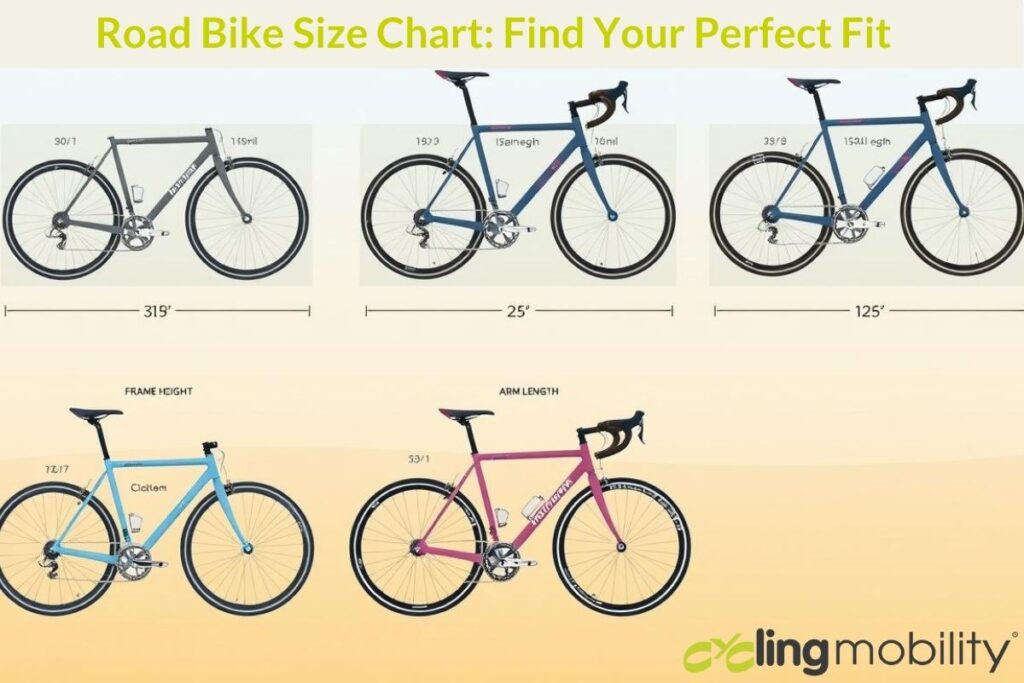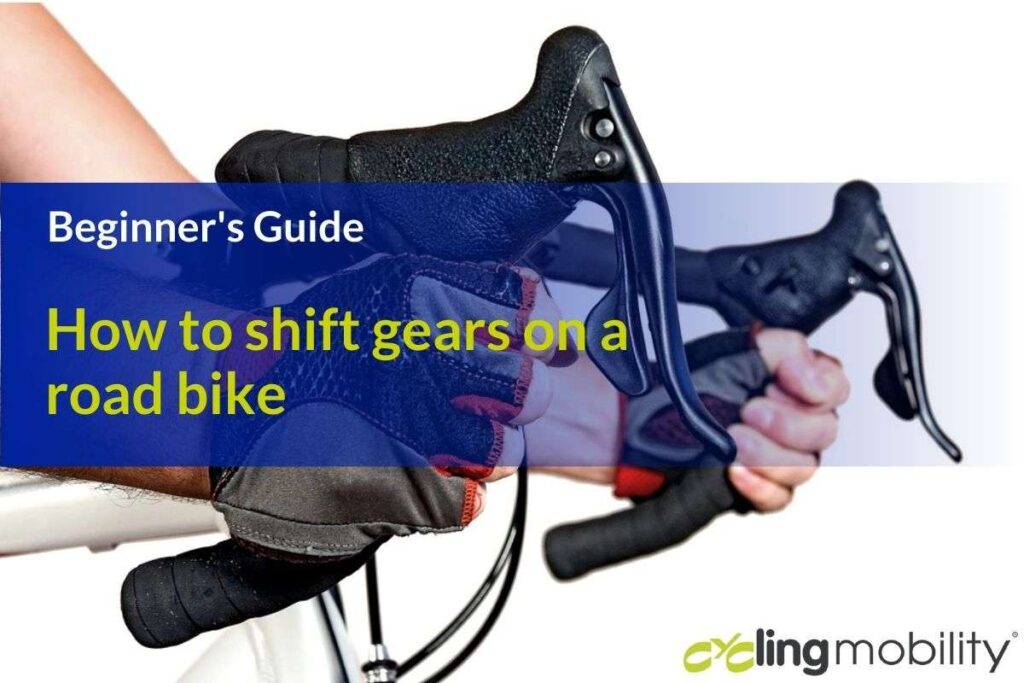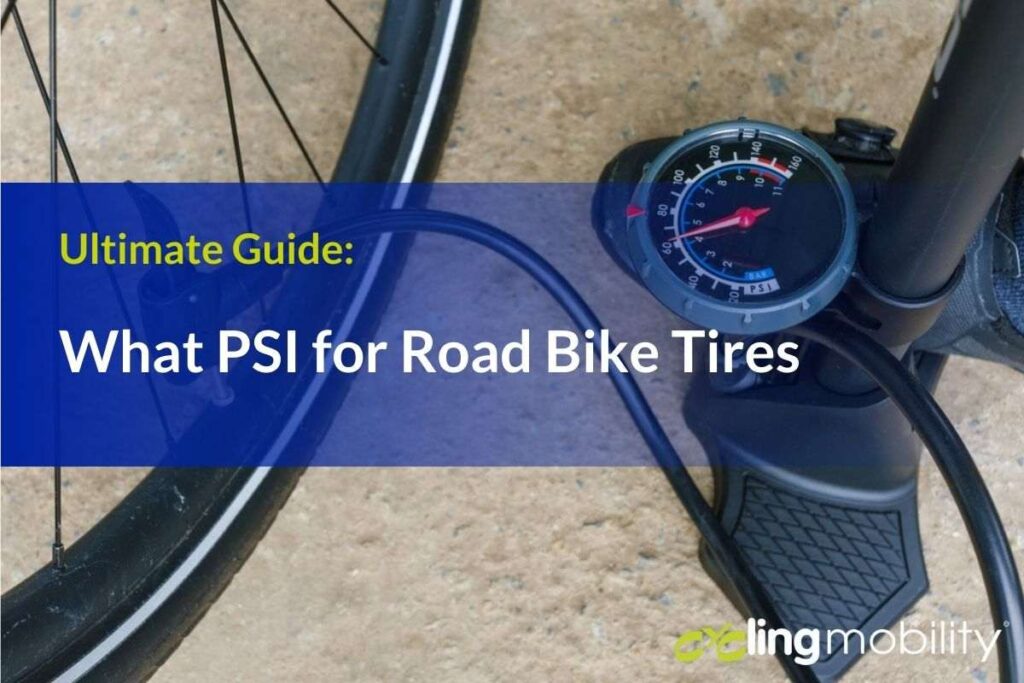Many cyclists face the issue of discomfort in their rear after biking. Whether you’re a seasoned rider or just starting out, knowing how to treat a sore bum after cycling is essential. Understanding the causes and finding the right solutions can make a big difference. Adjusting your bike properly, using the right gear, and taking care of your body after each ride are key steps to preventing and treating this common problem.
Key Takeaways
- Saddle sores are a common problem for cyclists, caused by friction, pressure, and irritation from the bike seat discomfort.
- Proper bike fit, including saddle height and position, is crucial for preventing saddle sores and ensuring a comfortable ride.
- Padded cycling shorts and chamois cream can help reduce friction and prevent infection.
- Treating saddle sores quickly with cleaning, drying, and the application of healing creams can aid recovery.

Understanding the Cycling Bum: Before and After the Ride
As a cyclist, your journey starts with excitement. Before you ride, you may feel soft and comfy. It’s a calm before the storm, a moment of peace.
The Pre-Ride Promise: A Bum’s Tale of Anticipation
Before you start, your cycling bum looks forward to fun. It doesn’t know about the hard ride ahead. It’s ready for the excitement.
The Mid-Ride Reality: When the Bum Meets the Bruise
As you ride, you start to feel the pressure building. Your sit bones become sore, and bruising sets in from the repeated impact. The ride’s harshness hits you hard.
The Post-Ride Plot Twist: A Bruised Bum’s Chronicle
After riding, your cycling bum tells a story. It’s sore, bruised, and needs care. The ride’s end brings a new chapter of discomfort.
Knowing the bum’s journey is key to cycling. From the start to the soreness later, it’s a story of challenge and care.
How to Treat a Sore Bum After Cycling: Immediate Relief Strategies
Cycling is fun and rewarding, but it can cause a sore bum or saddle sores. These painful spots can appear on your buttocks and genital area from the friction and pressure. Luckily, there are ways to ease the pain and help it heal.
One effective way to get immediate relief is to stop cycling. Get off your bike and let your bum rest. This can lessen the irritation and swelling.
Applying ice to the sore spot is another good strategy. The cold can reduce swelling and soothe the pain. You can use a cold pack or a bag of frozen veggies wrapped in a towel.
For more severe pain, consider using a cushion or gel seat cover. It can alleviate the pressure and give you immediate relief from the soreness, quick tips to improve:
- Take a break from cycling to allow your body to rest and recover
- Apply ice to the affected area to reduce swelling and soothe the pain
- Use a cushion or gel-filled seat cover to alleviate pressure on your bottom
Using these immediate relief methods can help ease the pain and aid in healing. Remember, preventing saddle sores is important. Wear the right gear and keep clean to avoid them.
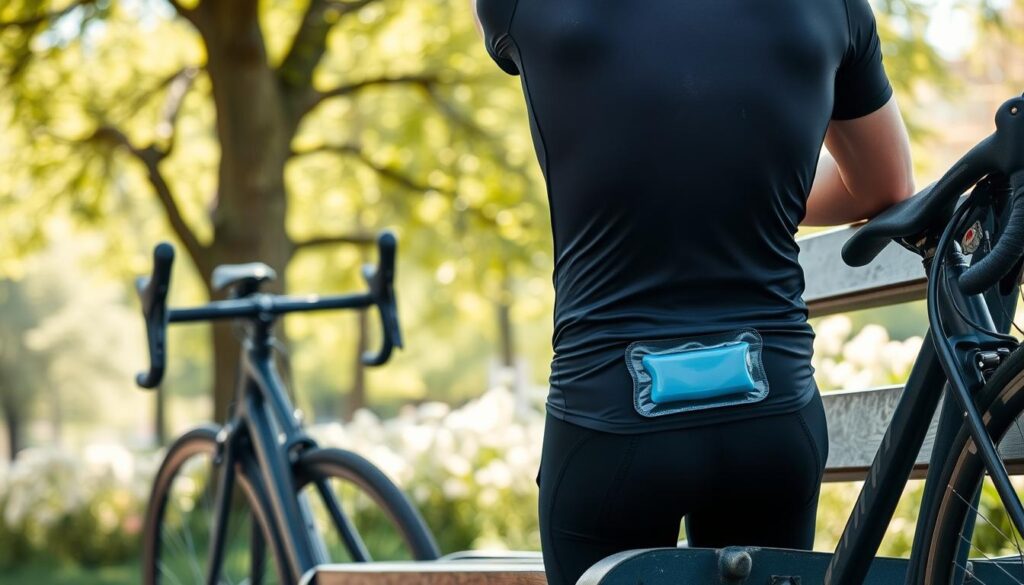
Post-Ride Care: Treating Your Bum Hurts After Cycling
After a thrilling bike ride, it’s key to cool down and care for your body. This is crucial for your butt pain, which has faced the saddle’s constant pressure and friction. By taking a few easy steps, you can ease the pain and speed up healing.
The Cool-Down: Easing Off the Saddle
Don’t rush off the bike right after you finish. Take a few minutes to pedal slowly. This post-ride care lets your muscles and blood flow return to normal. It helps prevent soreness and stiffness.
The Magic of Ice: A Chilly Reception for Soreness
Applying an ice pack or cold gel pack to your sore bum is a great idea. The cold tightens blood vessels, slowing blood flow and reducing swelling. This post-ride care offers quick relief and supports healing.
The Post-Ride Ritual: Embrace the Healing
Along with cooling down and icing, adding other recovery steps can help your days off the bike. Try a warm bath with Epsom salts to relax your muscles. Or, get a gentle massage to boost blood flow and recovery.
Long-Term Strategies for Sore Bum Cheeks from Sitting
Cycling is thrilling, but it can also cause some issues and muscle pain after cycling and after long distances sitting. Fortunately, there are ways to make it more enjoyable. With the right long-term strategies, you can ride comfortably without pain.
The Daily Grind: Strengthening the Seat of Power
Doing exercises every day can help your backside muscles. This strengthening makes cycling easier and less painful. You’ll feel better and ride more comfortably.
The Stretching Regimen: Flexibility for the Finish Line
Stretching regularly is key for cycling. It keeps your muscles and joints flexible. Spending time stretching your bum helps prevent tightness and boosts your cycling skills.
The Core of Cycling
Having a strong core is essential for cycling, as it supports your body and eases pressure, making your rides more comfortable and pain-free. A professional bike fit can further enhance your experience by ensuring that your bike is adjusted to your body while consulting a bike size chart helps you select the right size for optimal performance.
Incorporating these long-term strategies into your cycling routine is a smart move. They help build strength, flexibility, and core support, allowing you to enjoy cycling without the worry of discomfort.
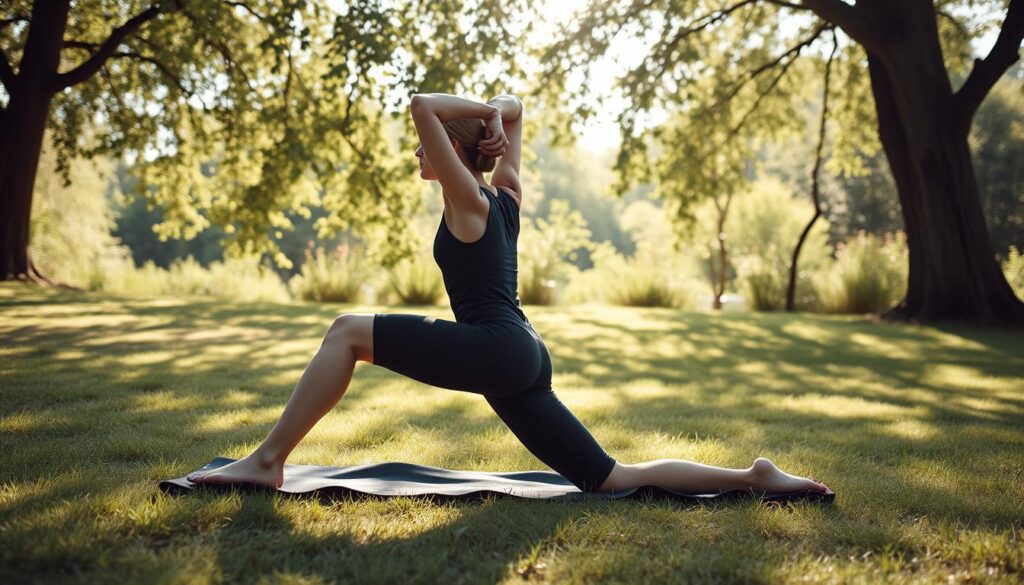
“Proper conditioning and preparation are key to preventing and managing saddle hurt. Investing in your long-term cycling health will pay off in more comfortable and enjoyable rides.“
Choosing the Right Equipment to Prevent a Sore Butt
Cycling is exciting and rewarding, but it can hurt your butt. To avoid this, getting the right gear is key. Padded shorts and the right bike saddle are must-haves for comfort.
The Padded Path: Shorts That Shield
Good cycling shorts with quality chamois are your first defense against a sore butt. The chamois cushions and supports your sensitive spots, easing the pressure from the saddle. Choose shorts that breathe and wick away moisture to stay cool and dry.
The Throne of Bikes: Picking the Perfect Saddle
When you first start cycling, you may not realize how much discomfort an incorrect saddle could cause. Finding the right bike saddle is crucial for comfort. The saddle should match your body and riding style to prevent any unnecessary pain. Don’t hesitate to try different shapes and materials until you find the best fit for you—it’s well worth the effort!
Accessorize for Assurance: The Extras That Matter
There are more accessories that can boost your comfort. Chamois creams prevent chafing, and seat cushions or gel pads add extra cushioning.
Getting the right gear is essential for a comfortable ride. By focusing on your butt’s comfort, you can enjoy cycling more and avoid soreness.
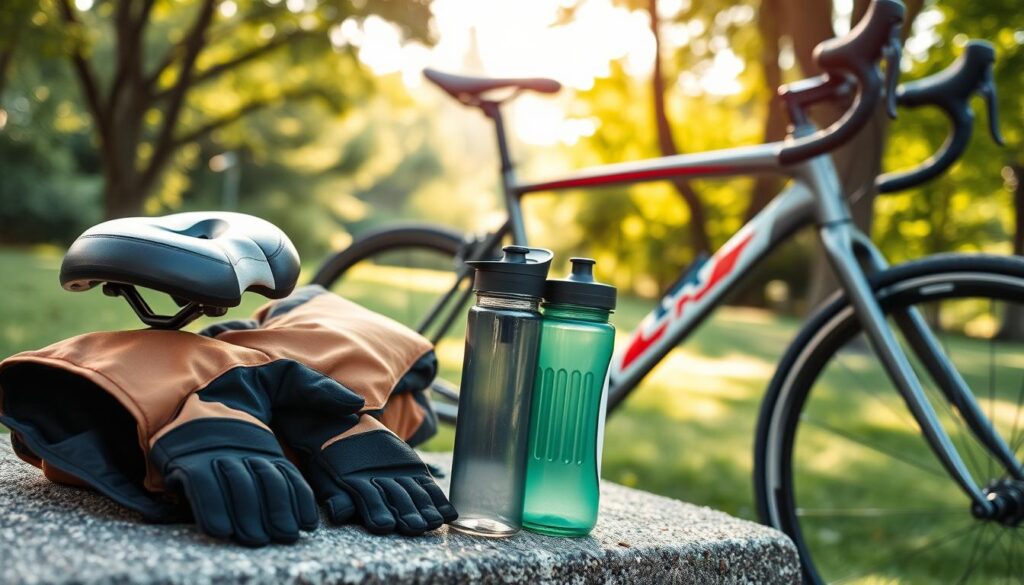
Take a Break: Why Rest is Essential
After a tough ride, your bum might feel sore. Rest helps your body, including your bum, to heal. If you keep pushing without resting, you might get worse problems like saddle sores. Taking a break lets your body fix any damage from cycling.
“The most effective treatment for a achy backside is simply to rest and allow the area to heal.”
While resting, do gentle activities like walking or light stretching. This keeps you moving without hurting your bum more. Try not to sit for too long and keep your weight off the sore spot. This helps it heal faster.
Remember, a break doesn’t mean you have to stop cycling. It’s about finding the right mix of rest and activity. With patience and the right approach, your sore bum will heal quickly.
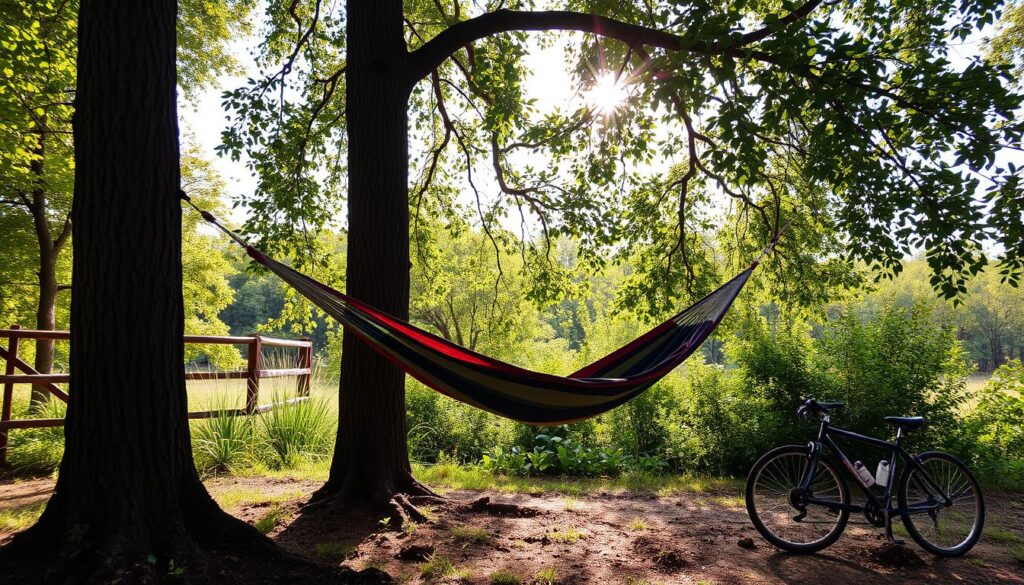
Apply Ice: Nature’s Anti-Inflammatory
Ice or a cold pack can really help. The cold tightens blood vessels, slowing blood flow and cutting down on swelling. It’s nature’s way to give you quick relief.
Ice is your top ally for a sore bum. It cools the area, easing pain and swelling. This lets your body heal faster. For the best effect, use the ice pack for 10 to 15 minutes, a few times a day. This natural method can greatly reduce your ice-y sore bum and its anti-inflammatory response.
“Ice is the MVP when it comes to managing saddle sores and cycling-related soreness. It’s an easy, effective way to provide relief and kick-start the healing process.”
But remember, don’t leave the ice on too long. It can cause more harm. Pay attention to your body and adjust the time as needed. With a bit of ice and patience, you’ll be cycling again in no time.

- Ice constricts blood vessels, reducing inflammation and pain.
- Apply the ice pack for 10-15 minutes, several times a day.
- Avoid leaving the ice on for too long to prevent further damage.
- Ice is a natural, effective way to soothe a sore bum and promote healing.
Try a Cushion: Alleviating Saddle Pressure
As a cyclist, a sore posterior can be a real pain. But, there’s a simple solution: using a cushion or pad designed for cycling.
These cushions help spread your weight evenly across the saddle. This reduces discomfort and the chance of saddle sores. By easing the pressure on your sore butt, you’ll enjoy a more comfortable ride.
When picking a cushion, make sure it fits your bike and body. Look for breathable, moisture-wicking materials. Also, consider extra padding or gel inserts for the best cushion and saddle pressure relief.
“Investing in a quality cushion can make all the difference in your cycling experience. It’s a small upgrade that can have a big impact on your comfort and performance.”
If you’re tired of a sore seat after rides, try a cushion. It might be the missing piece for your cycling comfort.

- Look for breathable, moisture-wicking materials in your cycling cushion.
- Consider extra padding or gel inserts for maximum comfort and pressure relief.
- Choose a cushion that fits your bike and body type for optimal support.
Wear the Right Clothing: Fabric and Fit Matter
When cycling, what you wear matters a lot for comfort and riding experience. The fabric and fit of your shorts are key to staying pain-free on the bike.
It’s important to wear clothes that breathe and wick away sweat. Look for clothing made from spandex, lycra, or polyester. These materials help prevent chafing. Also, make sure your shorts fit well but not too tight. A snug fit supports you without causing discomfort.
“Many cyclists with saddle discomfort will spend over $100 on a novelty “men’s” or “women’s” comfort saddle, but won’t spend more than $60 on high quality bike shorts.”
Good cycling shorts can change your ride. Look for ones with seamless, anti-bacterial fabric and moisture-wicking pads. Bib shorts are often preferred for their better fit and comfort.
Investing in quality clothing and fabric helps avoid a sore bum. It makes cycling more enjoyable. Spend time finding the best cycling apparel for you.
Keep Everything Clean: Preventing Irritation
As a cyclist, maintaining cleanliness is essential to avoiding discomfort and irritation in your rear. Good hygiene can prevent many issues that arise from cycling.
First, ensure that the buttocks and perineal area are clean and dry. After riding, wash with antibacterial soap to remove sweat, dirt, and bacteria, reducing the risk of infection and discomfort.
Using a quality chamois cream is essential. These creams have antibacterial and moisturizing properties, creating a barrier against chafing. Apply generously to the saddle contact areas before each ride.
Avoid shaving the area around any soreness. Instead, use a body groomer to prevent ingrown hairs and infections, which can lead to further discomfort.
“Proper bike fitting is also crucial in reducing pressure points, minimizing the risk of saddle sores.”
If saddle sores do occur, let them heal naturally. Avoid picking or pressing them, as this can delay healing and cause more pain.
By maintaining cleanliness and following these tips, you can stay comfortable and healthy after every single ride.

Healing Creams: Soothing and Protecting
Healing creams are a must-have for cyclists with sore skin. They often have natural ingredients that fight inflammation and bacteria. This helps your bum heal faster, whether it’s from general soreness or chafing.
Different Types of Creams for Biking-Related Soreness
Look for creams with aloe vera, calendula, or chamomile. These soothe inflammation and ease pain. Zinc oxide creams create a barrier to protect your skin from more irritation.
Creams for Chafing or Friction
To alleviate this, special creams are available that can provide relief and protect sensitive areas during your rides. Some reduce friction and prevent irritation. Others fight off infections. Using these creams after riding can help you heal faster.
Remember, the key to finding the right healing cream is to pay attention to the specific needs of your skin and the type of soreness you’re experiencing. Experiment with different formulas and ingredients to find the one that works best for you.
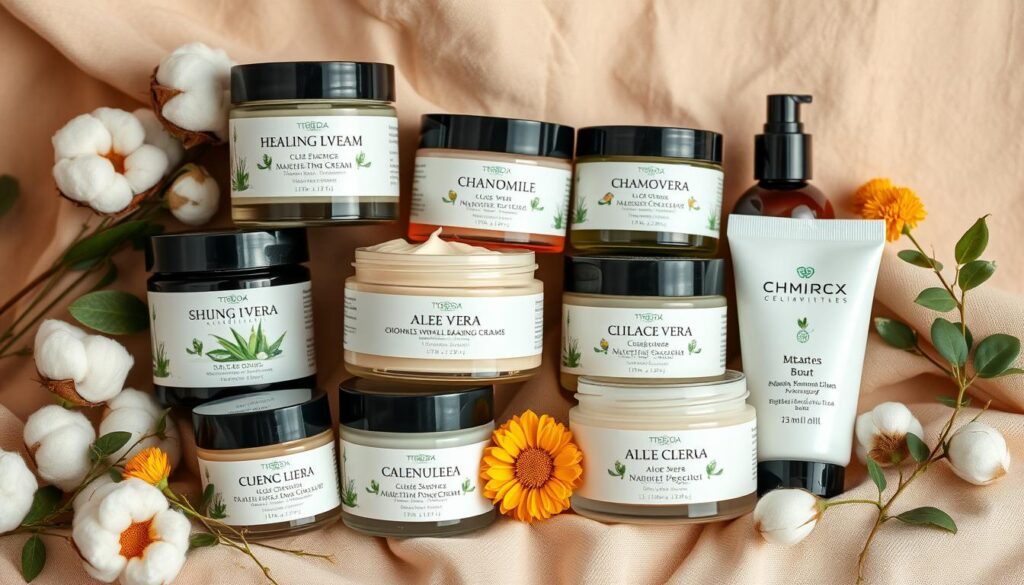
Conclusion
There are many ways to treat a sore bum after cycling. You can use quick fixes or long-term plans. These methods help make cycling more comfortable and fun, for both new and experienced riders.
Using ice packs and cushions can provide immediate relief. Choosing the right gear and maintaining good hygiene are also essential. Adding exercises and stretches can make your bum stronger and less sore.
Combining quick fixes with long-term strategies is the best way to deal with a sore bum. This approach helps cyclists enjoy their rides more. Remember, taking care of your body is crucial, so pay attention to its signals and use the solutions that work best for you.



